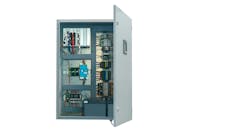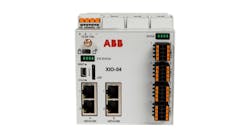Input/output (I/O) devices such as sensors, solenoids or drives may be mounted inside or outside a control enclosure, and more than ever in automation history the I/O system and device-termination method may be located inside or outside the enclosure, as well. And the use of discrete wires or digital-communication methods or both are always a design consideration.
I/O systems have advanced with automation technology over the years. Yet often field devices still connect to terminal strips in a control enclosure that are hardwired to input and output modules in a PLC rack. These rack-based and similar I/O modules are a good starting point and have been for years. However, I/O systems today take many forms.
Some just decrease cable bundles and move the termination point to outside of the enclosure, and other forms connect through a digital communication cable. All methods are still valid, and, in many instances, all methods are used in a single automation system.
Once upon a time, there were control cabinets full of relays used to control the automated sequence of industrial machines—doors and doors of cabinets in a row in a mezzanine above the automated systems. Over the years these relay control cabinets were replaced by PLCs, but all the wires to the field I/O remained in place—huge bundles with thousands of wires.
Replacing the hardwired relays with PLCs was a big deal, and never were rack-based I/O modules more popular. It was relatively easy to gut the relay control cabinets and install a PLC. The PLC racks took up less space than the relays, and the rack-mounted I/O modules were connected to the existing system's field device terminals.
Back then and as is today, expansion racks could be added, often with manufacturer-specific communication modules and protocols supporting thousands of I/O points. Over the years this rack-based I/O has shrunk to less than half the size it was with double the amount of I/O points per module. If you are happy to run all your field devices using discrete cables through a control cabinet bulkhead to terminal blocks, it's probably still the easiest to understand method of wiring, although somewhat labor-intensive during integration.
To shrink control cabinet size and reduce the size of the cable bundles entering and exiting it, sensor termination points have been moving outside of the main control enclosures for decades. Junction boxes, remote I/O and fieldbus I/O are three examples.
Before fieldbus technology was developed as it is today, junction boxes and remote I/O were some of the choices to move the I/O cable termination points outside the enclosure. The old-style junction boxes were filled with terminal blocks. One side of the terminals connected via discrete wires and cables to the rack-based I/O modules in the main control enclosure. The other side of the terminals connected to the field devices, such as sensors and solenoids via flexible cables. It required lots of wire, cable, conduit and bulkhead connectors. Many holes had to be drilled and conduit knockouts punched through the wall of the junction box—often dozens or more.
For a small machine, this may still work today, but a better solution is to use molded junction boxes. These molded junction boxes combine power and four, eight, 16 or more signals (ports) from a variety of sources into a single cable, with up to 18 or more conductors, that connect to the control panel terminals and then the rack-based I/O. Multiple cordsets connect the junction boxes' ports to field components such as sensors.
A big change happened to I/O systems around 1995 when Wago introduced fieldbus-independent I/O systems. This new I/O replaced the discrete wires in junction boxes and the rack-based I/O systems with a fieldbus coupler module and multi-channel input and output modules—like an electronic terminal strip.
All of the leading industrial I/O manufacturers soon followed suit, creating their own versions of fieldbus I/O systems. It's often vendor-specific, but all common industrial protocols, such as EtherNet/IP, will work with these remote I/O systems, connecting just about any industrial signal, digital or analog, to a multi-channel input or output module and then, through a fieldbus coupler, to a controller.
These remote I/O systems, similar to a row of terminals on DIN rail, moved the sensor and actuator terminations much closer to the field devices. This provides a much more modular and distributed system. With much less discrete wiring and cables, the modularity makes it easy to disconnect sections of machine I/O during shipping, for example.
The latest trend moves the I/O all the way out to the sensor and actuator connection using fieldbus I/O, often called block I/O or distributed I/O. Call it what you want, but these devices are similar to the multi-port, molded junction boxes but with the fieldbus solution built-in. Pick your protocol when specifying the device, and connect power and a communication cable.
What's the best solution? The technology and opinions vary, but sometimes a little rack-based I/O, remote I/O and fieldbus I/O are all part of a systemwide solution.
ALSO READ: The accumulating case for deterministic control
[sidebar id=2]






